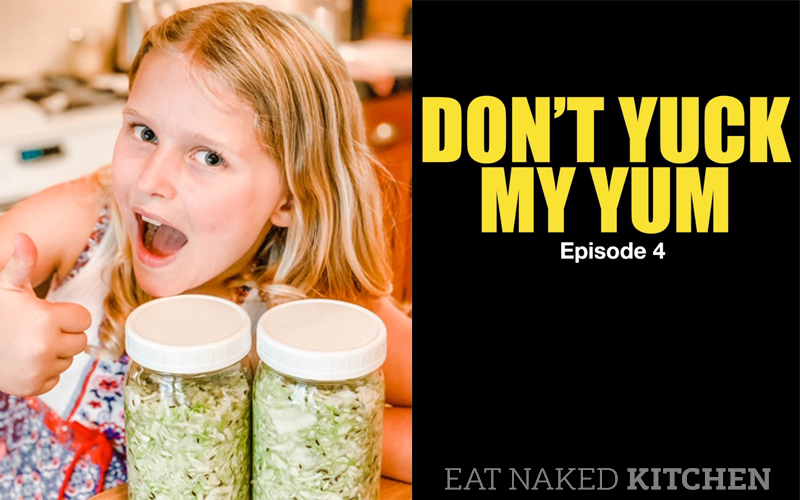We’re on a fermented foods kick over here at the Floyd-Barry household. We LOVE our ferments of all kinds: cultured veggies (aka homemade, lacto-fermented sauerkraut), pickles, kombucha, kim chi… We include something fermented with pretty much every meal we eat.
Fermented foods have a host of health benefits:
- Support digestive health
- Provide an excellent food source of beneficial bacteria (probiotics)
- Add enzymes to aid with the digestion of whatever you’re eating them with
- Help offset the carcinogenic effects of things like charcoal on BBQ’d foods
- Have an alkalinizing effect on the system
- Support immune health
They really are a superfood. In my first book, Eat Naked, I describe them as “better than naked” because the way they are prepared actually enhances their nutritional value rather than depletes it.
In the pre-kid days, we used to make all our own ferments. They’re fun to make and you save SO much money (for your basic cultured sauerkraut, compare $15-20/jar for store-bought to the $2-3 for a head of organic cabbage, sea salt, and caraway seeds…)
But then, kids happened, we got busy and the time saved was worth the extra money.
Until now!
With all of us stuck at home due to The Virus, we dusted off our trusty kraut pounder and showed the kids how it’s done. We’ve been experimenting with all sorts of ferments, and it’s been loads of fun – not to mention delicious.
This week on Don’t Yuck My Yum Sia shows us how to make your classic, naturally fermented sauerkraut.
RELATED: 7 real superfoods I eat everyday. And so should you.
Please subscribe to the ‘Don’t Yuck My Yum’ channel.
What’s your favorite fermented food or drink? Leave your comment below.
We hope you and/or your kids enjoyed the video. Be on the lookout for more ‘Don’t Yuck My Yum’ videos in the near future.
Did you like the content provided from Sia and Sasha’s video? Please consider donating towards their education fund.
Homemade Sauerkraut
Ingredients
- 1 head cabbage recommend regular green cabbage
- 2 Tbsp sea salt
- 1 Tbsp caraway seeds
Instructions
- If using a food processor, use the shredding blade. Cut cabbage into appropriate size to feed into the processor chute safely. Shred entire cabbage saving one large cabbage leaf and set aside.
- In a large bowl, add shredded cabbage, salt and caraway seeds. Using a blunt firm object, pound the cabbage for about 10 minutes to release juices.
- Fill a quart-sized, wide-mouth mason jar, pressing down firmly with a pounder or meat hammer until juices rise above the cabbage. Stuff the large leaf over the shredded cabbage to weigh it down. It is important that the shredded cabbage be submerged in the liquid. Leave about 1 inch of space at the top of the jar. Cover tightly and keep at room temperature for about 3 days before transferring to the refrigerator. The sauerkraut may be eaten immediately, but it improves with age. It keeps for months.




